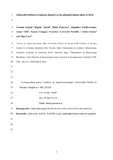Salmonella biofilm development depends on the phosphorylation status of RcsB
Fecha
2012Autor
Versión
Acceso abierto / Sarbide irekia
Tipo
Artículo / Artikulua
Versión
Versión aceptada / Onetsi den bertsioa
Impacto
|
|
10.1128/JB.00361-12
Resumen
The Rcs phosphorelay pathway is a complex signaling pathway involved in the regulation of many cell surface structures in enteric
bacteria. In response to environmental stimuli, the sensor histidine kinase (RcsC) autophosphorylates and then transfers
the phosphate through intermediary steps to the response regulator (RcsB), which, once phosphorylated, regulates gene expression.
Here, we show t ...
[++]
The Rcs phosphorelay pathway is a complex signaling pathway involved in the regulation of many cell surface structures in enteric
bacteria. In response to environmental stimuli, the sensor histidine kinase (RcsC) autophosphorylates and then transfers
the phosphate through intermediary steps to the response regulator (RcsB), which, once phosphorylated, regulates gene expression.
Here, we show that Salmonella biofilm development depends on the phosphorylation status of RcsB. Thus, unphosphorylated
RcsB, hitherto assumed to be inactive, is essential to activate the expression of the biofilm matrix compounds. The prevention
of RcsB phosphorylation either by the disruption of the phosphorelay at the RcsC or RcsD level or by the production of a
nonphosphorylatable RcsB allele induces biofilm development. On the contrary, the phosphorylation of RcsB by the constitutive
activation of the Rcs pathway inhibits biofilm development, an effect that can be counteracted by the introduction of a nonphosphorylatable
RcsB allele. The inhibition of biofilm development by phosphorylated RcsB is due to the repression of CsgD expression,
through a mechanism dependent on the accumulation of the small noncoding RNA RprA. Our results indicate that unphosphorylated
RcsB plays an active role for integrating environmental signals and, more broadly, that RcsB phosphorylation
acts as a key switch between planktonic and sessile life-styles in Salmonella enterica serovar Typhimurium. [--]
Materias
Salmonella,
Biofilm,
RscCDB,
CsgD,
Unphosphorylated response regulator
Editor
American Society for Microbiology
Publicado en
Journal of Bacteriology, July 2012, vol. 194, no. 14, 3708-3722
Notas
Incluye 1 fichero de datos
Departamento
Universidad Pública de Navarra/Nafarroako Unibertsitate Publikoa. IdAB. Instituto de Agrobiotecnología / Agrobioteknologiako Institutua
Versión del editor
Entidades Financiadoras
A.T.-A. and J.V. were supported by Ramón y Cajal contracts from the
Ministerio de Ciencia e Innovación, Spain. This research was supported
by grants BIO2008-05284-C02-01 and BIO2010-18885 from the Spanish
Ministerio de Ciencia e Innovación and IIM13329.RI1 from the Gobierno
de Navarra (Spain).






